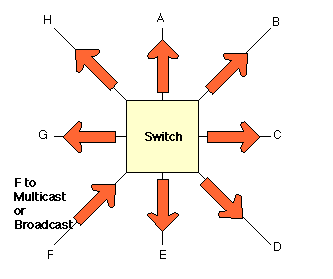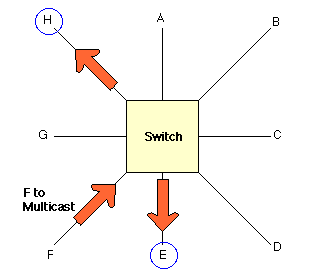An Ethernet Switch is a LAN interconnection device which operates at the data link layer (layer 2) of the OSI refrence model. A switch is fundamentally similar to a bridge, but usually supports a larger number of connected LAN segments and has a richer management capability.
Modern LANs have increasingly replaced the shared media with a switched media, by installing Ethernet switches and bridges in place of hubs and repeaters. These logically partition the traffic to travel only over the network segments on the path between the source and the destination. This reduces the wastage of bandwidth which results from sending the packet to parts of the network which do not need to receive the data. There are also benefits from improved security (users are less able to tap-in into other user's data), better management (the ability to control who receives what information (i.e. Virtual LANs) and to limit the impact of network problems), and the ability to operate some links in full duplex (rather than half duplex required for shared access).
Architecture
At the centre of a Switch is a type of switching element which controls the ports to which each frame is forwarded. Three types of switching element have been used, each has some merits in terms of cost/performance:
- Matrix Switches
- Shared bus
- Shared Memory
In addition, many switches include processing capability beyond that required for forwarding. This may be used to implement additional features.
Switches and Multicast Traffic
Many Ethernet switches handle multicast traffic as if were broadcast traffic. When a multicast packet reaches such a bridge/switch, it forwards the packet to all active interfaces, effectively flooding the network. This ensures all clients receive the multicast data, but has the drawback that every LAN segment carries all the multicast traffic, even when the directly connected clients do not require the data. This mitigates most of the advantages of switching when considering multicast traffic.

A bridge/switch may be designed to provides multicast support by implementing filters at the output ports of the device which remove the packets for which the clients attached to the ports have no registered interest. This operation resembles the processing for Virtual LANs (VLANs) and may be performed using the same/similar processing engine. Three approaches are possible when configuring this style of operation:
- Manual table configuration The network manager determines which clients should receive which multicast packets, in the same manner that VLAN membership is configured. Many multicast applications however select their multicast groups dynamically as the application executes.
- "Snooping" the multicast "Join" and "Leave"messages sent by clients. Clients use a protocol called the Internet Group Management Protocol (IGMP) to register the address groups in which they have an interest with their local multicast router. Some switches (e.g. FORE, 3COM) are able to monitor/emulate these packets and use the information to configure the switch filters dynamically
- Down-loading a switch filter table from the local multicast router. Each IP multicast network must have at least one multicast. The router must track the multicast membership of each client, and may utilise this information to inform the switch which clients require which packets. In practice, this may be as simple as down-loading a multicast address filter table to all attached switches. Most CISCO equipment support the CISCO Group Management Protocol (CGMP) to provide this function.

Some level of multicast filtering is highly desirable within a bridge/switch handling multicast traffic. These procedures allow a the device to selectively forward multicast packets only to hosts which register an interest in the corresponding multicast group address. Without the addition of such procedures, Level 2 bridges/switches are forced to broadcast multicast packets to all connected LANs. While manual configuration may suffice for applications such as multicast file transfer, or multicast distribution to network news/web cache clients. For the majority of multicast applications, one of the two dynamic schemes is recommended.
Some level of multicast filtering is highly desirable within a bridge/switch handling multicast traffic. These procedures allow a the device to selectively forward multicast packets only to hosts which register an interest in the corresponding multicast group address. Without the addition of such procedures, Level 2 bridges/switches are forced to broadcast multicast packets to all connected LANs. While manual configuration may suffice for applications such as multicast file transfer, or multicast distribution to network news/web cache clients. For the majority of multicast applications, one of the two dynamic schemes is recommended..
No comments:
Post a Comment